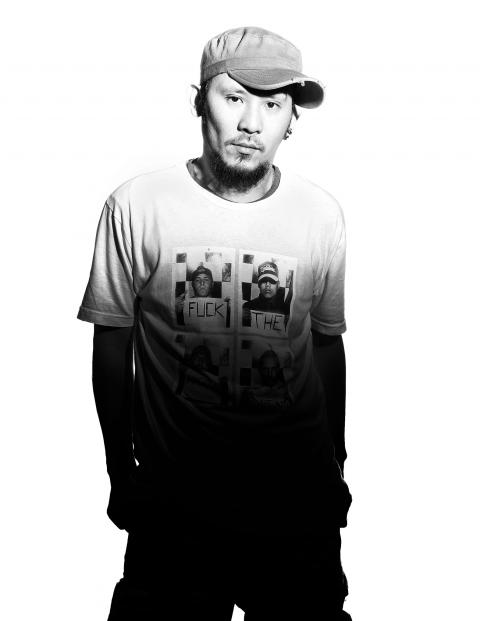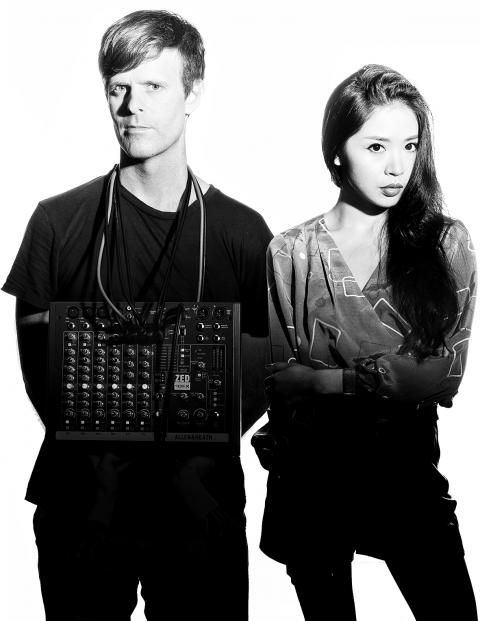It’s hard to believe that only five years ago, the DJ stage at Spring Scream was placed in a corner of the park partially obscured by trees. Now, it has become one of the centerpieces of the whole festival and home to some of the wildest times because for the past two years, the main DJ stage has been in the shape of a huge octagon with speakers all facing inward from all corners. This means that the sound in the middle is booming and doesn’t bleed to other stages.
There are nearly 40 artists that will grace the two DJ stages at Spring Scream this year (full disclosure: I am the DJ stage manager). Their styles of music range from ethereal soundscapes to hard electro and everything in between. There are numerous virgins that will be popping their cherries behind the decks at Spring Scream this year including The Language Lab (語言實驗室), who sound like a soundtrack to a kung-fu flick, P-LaLa, a resident DJ at Brickyard in Kaohsiung who is getting quite the reputation for making people move to her combination of Latin and dance music sounds and Dronetonics, a synth-heavy, experimental band that uses an abundance of effects.
Surprisingly, 10-year veteran DJ, D. Hooker (birth name Dominik Tyliszczak), has never played at Spring Scream. This year, he’ll be doing double duty as a DJ and his alter ego video artist, Dr. DMT. “For the video, I’ll be trying to bring something that will have a strong visual impact and tantalize the retinas,” D. Hooker said. “We’re working on making this year’s DJ stage a memorable one, while at the same time not following set-ups commonly found at a typical outdoor party.”

Photo: Up Against the Wall
D. Hooker’s sounds are also a break from the norm. “Musically, I always try to bring something a little different to the stage with me,” he said. “With well over one million tracks on music sites like Beatport, it’s really surprising that in main clubs you are likely to hear only the same 100 or so tracks on any given night. The challenge is to get the audience responding but show them something different.”
The thing about the DJ stages is that you never know what to expect. If you like music hard, then you don’t want to miss Zo, Chamber, James Ho, Physical Chemical Brother (理化兄弟), and amSTEREO. If you love house music, then Digital D and Utopia will help you get your fix. If you like hip-hop, look for MC Yen (MC顏), FJ, or DJ NeKbrace. And if you have a burning desire to find out what trance metal sounds like, make sure and catch xzw.

Photo: Up Against the Wall

May 26 to June 1 When the Qing Dynasty first took control over many parts of Taiwan in 1684, it roughly continued the Kingdom of Tungning’s administrative borders (see below), setting up one prefecture and three counties. The actual area of control covered today’s Chiayi, Tainan and Kaohsiung. The administrative center was in Taiwan Prefecture, in today’s Tainan. But as Han settlement expanded and due to rebellions and other international incidents, the administrative units became more complex. By the time Taiwan became a province of the Qing in 1887, there were three prefectures, eleven counties, three subprefectures and one directly-administered prefecture, with

It’s an enormous dome of colorful glass, something between the Sistine Chapel and a Marc Chagall fresco. And yet, it’s just a subway station. Formosa Boulevard is the heart of Kaohsiung’s mass transit system. In metro terms, it’s modest: the only transfer station in a network with just two lines. But it’s a landmark nonetheless: a civic space that serves as much more than a point of transit. On a hot Sunday, the corridors and vast halls are filled with a market selling everything from second-hand clothes to toys and house decorations. It’s just one of the many events the station hosts,

Among Thailand’s Chinese Nationalist Party (KMT) villages, a certain rivalry exists between Arunothai, the largest of these villages, and Mae Salong, which is currently the most prosperous. Historically, the rivalry stems from a split in KMT military factions in the early 1960s, which divided command and opium territories after Chiang Kai-shek (蔣介石) cut off open support in 1961 due to international pressure (see part two, “The KMT opium lords of the Golden Triangle,” on May 20). But today this rivalry manifests as a different kind of split, with Arunothai leading a pro-China faction and Mae Salong staunchly aligned to Taiwan.

Two moves show Taichung Mayor Lu Shiow-yen (盧秀燕) is gunning for Chinese Nationalist Party (KMT) party chair and the 2028 presidential election. Technically, these are not yet “officially” official, but by the rules of Taiwan politics, she is now on the dance floor. Earlier this month Lu confirmed in an interview in Japan’s Nikkei that she was considering running for KMT chair. This is not new news, but according to reports from her camp she previously was still considering the case for and against running. By choosing a respected, international news outlet, she declared it to the world. While the outside world